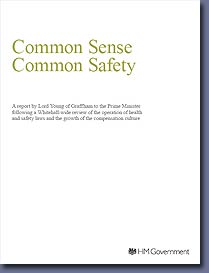 |
 |
|
Concentrating on what Lord Young calls 'low hazard workplaces' without determining exactly what he means by 'low hazard' clearly introduces several tears of workplaces, reducing the responsibility to the health, safety and welfare of the employer depending upon an arbitrary level of hazard. However, in the main body of the report under the heading 'Risk assessments in low hazard workplaces' it is clear that realities in the UK working environment are ignored as the report minimises and ignores two of the biggest risks in so-called low hazard working environments. To quote: Low hazard workplaces are places where the risk of injury or death is minimal. These include shops, offices and classrooms.The latest figures show that only around 3% of all workplace injuries in Great Britain involve offices and that no office workers died as a result of accidents at work in 2009.The main risks encountered in a low hazard workplace include repetitive strain injury, injuries from lifting and moving things and minor slips and trips. It clearly ignores the fact that MSDs and Stress are the main factors of risk in all work places. Again a simplistic view is taken about home workers. It attempts to remove all responsibility for the health safety and welfare of those deemed by their employer to be able to work from home by exempting employers from risk assessments for all employees working in their own homes. This means that substandard working environments and furniture will become the norm for home workers and will see an increase in msds and stress amongst home workers with no legal redress or protection for home workers. It also provides nothing new in the sense that whilst referring to simplified risk assessments for low hazard workplaces, the practice of simplifying all risk assessments has been a long and ongoing practice amongst health and safety practitioners; and promoted by the HSE. It also talks of the HSE being instructed to provide examples of risk assessment procedures for low hazard workplaces, again something it has been doing for many workplaces irrespective of risk level. Indeed Trade Unions and their Safety Reps have been focused on simplifying risk assessments and procedures in partnership with employers. In simple terms, once again this seems to be an exercise in educating the business community about health and safety and making it all as simple for them as possible. A concept that the Trade union movement and USR have been grappling with for years. The problem is not that health and safety is over complicated in general, it is just that business does not want to be bothered with it and puts profit before the health safety and welfare of its employees. A perfect example of this is the Chilean mining disaster. But whist this may be an extreme example, the thousands of workers injured each year at work, and not just in high risk industries, exemplifies the general approach of most employers toward their responsibilities. The document states: Low hazard workplaces In terms of standards, once again Lord Young introduces nothing new that the Trade Union movement and health and safety professionals haven't been calling for, for many years. Indeed a registry of health and safety consultants has been run by IOSH for some time. Excerpt from this section of document reads: Raising standards As expected the EU is under attack and blamed for over prescriptive legislation and attempting to achieve no risk workplaces. •
The current raft of health and safety regulations should be consolidated into a single set of accessible regulations. The attempt to put all Health and safety Legislation into one single set of regulations has been tried before - and failed - mostly because of business demanding separate sections to legislation documentation. The recent changes to Fire Safety legislation is a prime example. Again, something that Trade Unions and USRs have been calling for is a review of RIDDOR, but extending the reporting period to seven days from 3 may be contentious: •
Amend the Reporting of Injuries, Diseases and Dangerous Occurrences Regulations 1995, through which businesses record workplace accidents and send returns to a centralised body, by extending to seven days the period before an injury or accident needs to be reported. Further recommendations deal with the combining of Food Standards and Health and Safety inspectors within local authorities and the Police and the abolition the Adventure Activities Licensing Authority replacing licensing with a code of practice. On a positive note it is worth highlighting Annexe D in the report entitled: Behind the myth: the truth behind health and safety hysteria in the media. This section applauds the HSE's Myth of The Month section of their website and criticises the media for the trivialisation of health and safety. Sadly though, this report purely panders to prejudice, shows a complete lack of knowledge about health and safety and a realistic understanding of the working environment in this country. A trip on the buses and trains with people going to work would inform Lord Young to the realities of UK working life - full of stress, cost cutting, and a general risk to most people's health safety and welfare. The report ignore all of this and in fact does not deal with health and safety at all!! Formal responses from the Trade Unions and health and safety bodies will be made available on this website as soon as they become available. You can download the full report from the E-Library Database using the search word 'HSReview' Source: Lord Young's Review Document / Unionsafety
|
 A quick review of the Executive Summary to Lord Young's report may give the impression of a reasonable approach to health and safety, but in fact has implications for every working person and their working environment.
A quick review of the Executive Summary to Lord Young's report may give the impression of a reasonable approach to health and safety, but in fact has implications for every working person and their working environment.